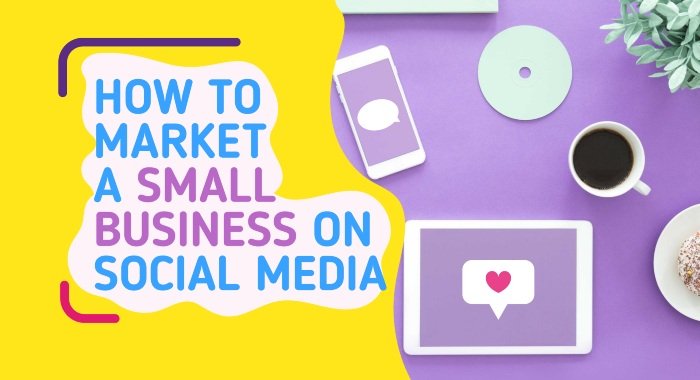It seems like everyone has social media nowadays and that is why you need to know how to market a small business on social media.
Even my grandma, who refuses to get wifi in her home because she doesn’t trust it, has a Facebook account.
Currently, there are over 3.8 billion people around the world that use social media. That’s over 50% of the entire world’s population. It’s an insane number of people that’s nearly impossible to visualise.
That’s the equivalent of the population of China, India, the UK, the US, Russia, Nigeria, Brazil, Bangladesh and Indonesia combined.
Social media is only going to carry on getting bigger. That’s why more and more businesses are putting their time and budgets into social media. In fact, social media spending is expected to rise by 73% over the next five years. Wow.
If you’re not already taking advantage of social media, now is the time.
Why small businesses need social media
Social media isn’t something that only giant corporations can profit from. It’s an excellent way to advertise your business online, making more people aware of your company and bringing more customers through your door.
The top benefits of knowing how to market a small business on social media are:
Greater brand awareness
People who wouldn’t have come across your business normally will now start to see your name on social media. In turn, these people can also share you with their friends and family, growing awareness of your brand.
Lost the buzz for your business?
Starting a business is exciting. Succeeding is rewarding. The bit between is hard, repetitive, and full of self-doubt.
The Lonely Middle Club (From Business4Beginners) helps you through it:
Get support and advice from other small business owners
Remove the self-doubt that’s holding your business back
Learn techniques and strategies to grow your business faster
Be inspired with our exclusive ‘swipe’ file and AI-powered tools
No pressure – work at YOUR pace, towards YOUR goals
—
More traffic/leads
Social media provides another avenue to advertise your business, helping bring more customers to your website, your store, or to get in touch with your business.
More trust
Social media also gives people space to post reviews and real opinions about your brand or service, helping to build trust with new customers.
Building relationships
Social media is your chance to talk to and interact with your customers, helping strengthen the relationship that you’ve built with them. This will increase loyalty and trust in your brand.
Encourage repeat purchases
Has someone bought form your brand in the past? Social media is a great way to reconnect with these people and encourage them to buy again.
Sounds like something you want to be a part of? Read on to find out how to market a small business on social media.
How to market a small business on social media
There are many different ways to market a small business on social media. Fundamentally, getting started will involve these three steps:
- Outline your goal;
- Pick the right social media platforms;
- Build your strategy.
Easy right? That’s just three steps. Now, let’s break down what each one actually means.
1. Outline your goal

Nothing in marketing can be done without a goal. Before you get started with social media, you need to outline exactly what you want to achieve with it.
- Do you want to increase your awareness?
- Do you want to increase traffic to your website?
- Do you want to up your leads and sales?
Whatever it is, think about that first. Everything that follows will be selected to help you with this goal.
2. Pick the right social media platforms
Not every social media platform is the same and the way how to market a small business on social media will vary accordingly. Each one has it’s own benefits and audience, so picking the right ones to be on will be essential for your success.
These are some of the biggest platforms you might want to consider.
Facebook is the biggest social media platform around. Currently, it has over 2 billion active users on it per month, attracting more than 65 million businesses using Facebook Pages and more than six million advertisers to the platform.
It’s a huge place for businesses to advertise on.
One of the reasons it’s so successful is that the groups and pages features allow users to easily find and join communities. This means it’s easier to target likeminded people who share similar interests to your business, building a community. With their messenger feature, it’s also easy for users to contact your business.
The downside? Users often expect an instant response on social media. If someone messages your page and don’t hear back for a couple of hours, it will negatively influence their opinion of you.
This means you’ll need someone able to respond to requests 24/7, or invest in chatbox features to automatically respond to common queries.

Instagram is one of the biggest platforms for both influencers and hobby enthusiasts alike.
It’s a photo-led platform making it perfect for visual companies. If you’ve got a physical product, or offer services like design, photography or artwork – Instagram is THE place to show it off in style.
The downside? If your business isn’t visually led, you’re going to have a hard time engaging users on Instagram. You also can’t use links on your posts, so if you’re using it to try and increase traffic to a blog, you might not find success here.
YouTube
YouTube is the world’s second-largest search engine behind Google. It’s where people go when they want entertainment, when they want advice or when they want to see how something is done.
If you sell knitting supplies, YouTube could be the place to post how-to videos of certain techniques or patterns. Similarly, if you sell building supplies, you can post how-to videos of how to build furniture or transformation videos of recent projects that you might have done.
The downside? Creating quality videos takes a lot of time and potentially new resources that you might not have at hand. For some businesses, this is an unseen expense that you just can’t afford right now.
In addition, you also need to be confident behind the camera. If everyone on your team is camera shy, the video platform might not be right for you.
X (Formerly Twitter)
X is the platform to go to when you want to find out what’s happening now. It’s made of small tweets – providing a snapshot of what is currently happening. It’s one of the easiest platforms to start and join in on conversations with your audience and building a community by taking part in online events or popular hashtags.
The downside? X moves fast, meaning that your content is more likely to get lost amongst the noise. It also means that you need to post more to keep it active, meaning possibly several tweets a day.
LinkedIn is known as ‘the professional network’. It’s primarily made of working professionals, using the platform as a virtual CV to promote their successes, network with other businesses and even explore new jobs in the area.
But LinkedIn isn’t just a job website. It holds many advantages to businesses, particularly in the B2B (Business to business) sector.
The downside? LinkedIn has the worst algorithm from any social media platform. This means that the platform often gets stuck showing updates from weeks ago that it thinks you might be interested in, rather than new updates. So if your post doesn’t get much engagement, it might be because people just aren’t seeing it in their feeds.

Like Instagram, Pinterest is another visual platform that you might want to take advantage of. In fact, it’s the only social media platform that offers a visual search. That means people can search for content based on a specific image.
So if a user is thinking of redecorating, they might search an image of a style they like. If your business comes up with one of your products that suits their style – then you’ve just caught their attention.
The downside? Pinterest can be a little confusing for first-time users as you have to create pins on boards, rather than post directly to your profile. But once you’ve got over that learning curve, it can offer many potential benefits to your business.
TikTok
TikTok is a newcomer in the social media world, but is quickly becoming one of the most popular apps of 2020.
TikTok is a video platform where people can record, watch and post videos. If you remembered Vine before it died, it’s a little similar to that, only there’s no 6-second limit. If you’ve seen a flood of people record themselves doing unique dances or challenges, it’s come from TikTok.
The downside? TikTok is still relatively new, meaning there’s a lot of unexplored territories here. For the most part, it’s filled with user-generated content so it may be hard to establish a business presence on it.
Top tip!
You don’t have to be on every social media platform. Trying to use all of them will just stretch your time too thin, meaning you’ve got fewer resources for the ones that actually matter.
It’s much better to have a solid strategy on one platform, than a rough presence on everywhere. So, know where your strengths are at and play to them. It’ll be much better in the long run.
3. Build your strategy
You have your goals. You have your platforms. Now it’s time to think about what exactly it is you’re going to post on them.
You can’t just post anything on social media. Each post needs to be thought out and align with your wider goals. It needs to be consistent, otherwise, you’ll end up creating a really confusing image of your company online.
Similarly, you need to think about why your users will want to follow you. Let’s say your goal is to increase sales and leads. To do this, you might be tempted to just post a lot of products that you sell and hope that your followers want to buy them.
That’s not a good strategy because there’s no benefit for your followers. Put yourself in their shoes and think about what they would want from your business first. Then think about how all of this can work towards your wider goal of increasing sales.
Struggling for ideas? Check out our guide to 5 small businesses killing it on social media.
Or, Read on to find inspiration for how to market a small business on social media.

Top tip!
Posting on social media shouldn’t mean that you’re up at all hours pushing out content online. To make the most of your time, you might want to consider getting a social media management tool, like Hootsuite or Buffer.
These platforms do have a free option to get started, helping you schedule posts in advance to really get the most from your social media.
Social media marketing ideas for small businesses
If you’re looking for ideas for how to market a small business on social media, we’ve come up with a few top tips to get you started…
1. Share the content you’ve already got
If you already run a blog or have some videos to hand, don’t let them go to waste! These are great to share across social media, making your brand look more like business leaders and giving your users something to interact with.
2. Run a competition
Social media competitions or giveaways are great ideas to help small businesses get noticed online. All you need is a good prize that your users will want and to set out the rules. Then, users just have to follow your brand or share your post to enter.
If you want to make it a bit more complex, you can get people to do something special to enter, like pose with your product, give something a name, or design something new. As a general rule, the more effort people put into your competitions, the bigger the prize should be.
Not only will competitions increase your immediate following, but it will also build trust in your company when you announce the winner.
3. Share tips/industry insights

You are the experts of your industry.
One way to show this is to share tips or insider knowledge from that industry to help your users. This doesn’t just show your expertise, but can also provide real useful information to your users that will make them want to keep following you.
4. Host an AMA
An AMA (Ask me anything) is a chance for users to ask questions directly to your business, finding the answers they’ve always wanted to know. Like the above tip, this is also a great way to show off your expertise.
Because AMA events often happen at a particular time, it also increases engagement as your followers will have to ‘attend’ the event to get their question answered.
5. Show off the hidden personality of your brand
Social media is a great place to put the spotlight on the unseen people behind your business. For small businesses, it provides a great opportunity for people to get to know your team and see the real, human side of your business.
To do this, you could post pictures ‘introducing’ your staff, share some silly moments that have happened behind the scenes or post unique pictures of your staff at work. All with their permission, of course.
6. Share ready-made audience content
Social media doesn’t just allow you to interact with your audience, it also allows you to use them as case studies or spokespeople of your brand.
If someone has made a post about your business or product or taken a picture of themselves using it, reuse that content! It will help build trust with your followers by showing them real examples of your product, while also strengthening the existing relationship that you have with your customers.
If you wanted to take it a step further, you could also approach some influencers on social media and also ask them to talk about your brand in front of their audience. But that’s a tactic that’s best left for later.
Don’t be tempted to buy followers

When you’re setting up a social media presence as a small business, it might be tempting to skip trying to build an audience and just buy your way to a good following.
This is a bad idea and a waste of money.
Buying social media followers very rarely pays off. In most cases, the followers that you buy aren’t real. They’re robots or spam accounts that exist just to bump up your follower count. They’ll never like or interact with your posts and never buy from your business. In effect, they are useless.
Having followers is only good if they’re the right audience. So, ignore your follower count for now and focus on making quality posts that your audience will enjoy.
Thinking of upping the budget?
Paid ads are a way to get your message directly in front of your customers.
Although they may sound daunting, using paid advertising isn’t as complex as it seems. You set up an advertising account, set a budget, and build your creatives. It doesn’t need to cost a fortune either as you can put exactly how much spend behind your ads as you want.
If you’re thinking of advertising on social media, there’s plenty of options for small businesses such as Facebook advertising or Twitter.
Looking for more online tips?
We’ve got you covered. Check out our tips and guides for online business here.







